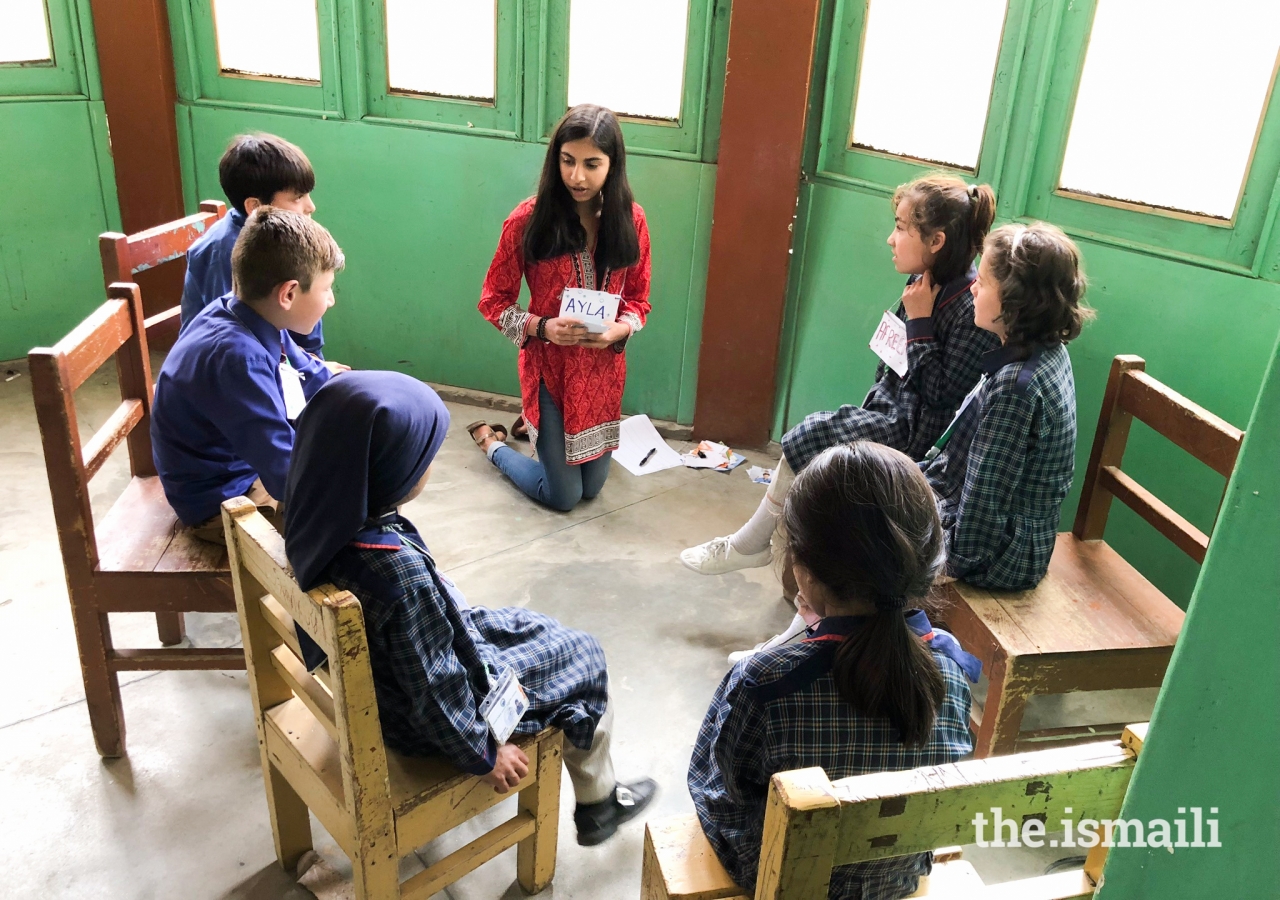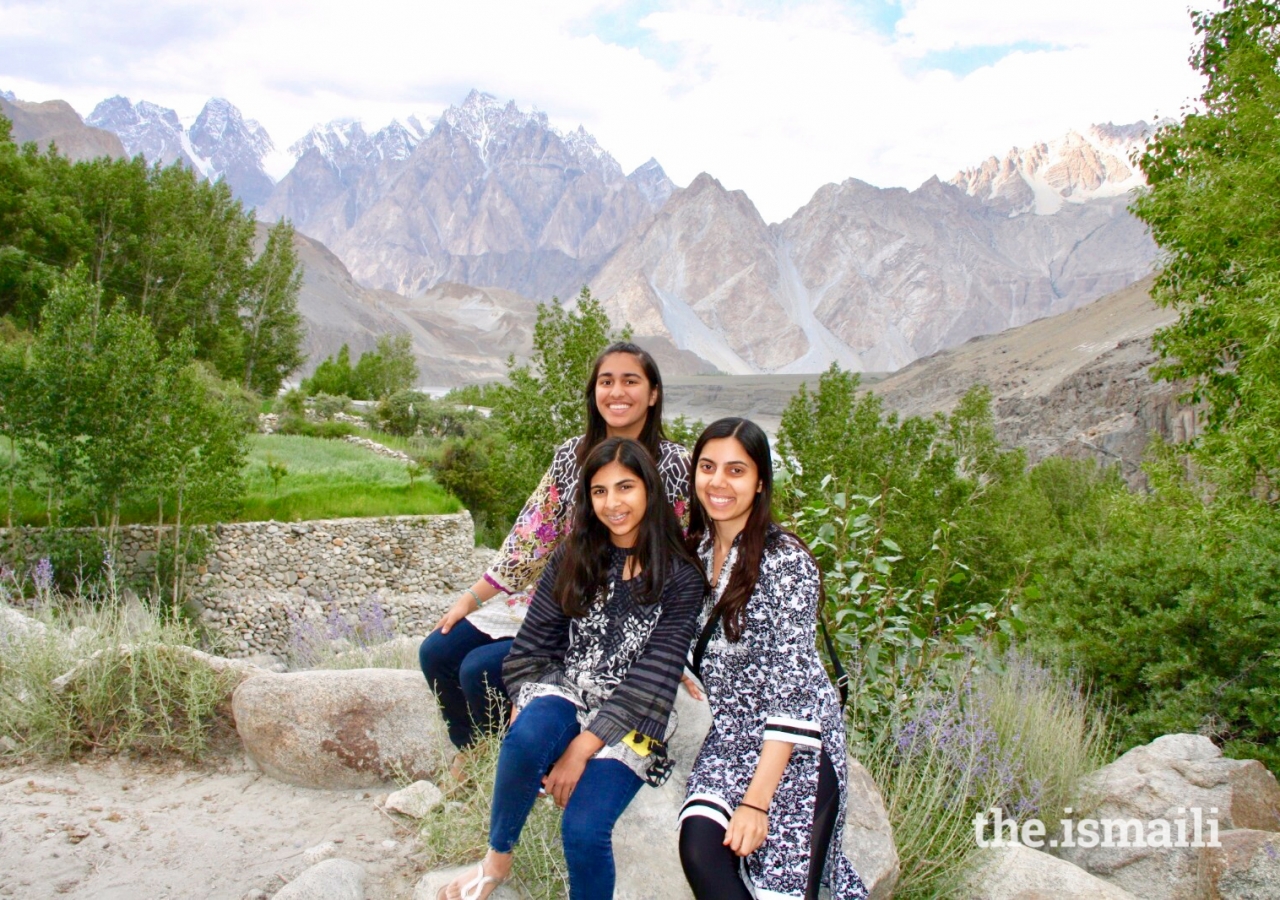AKEB in Pakistan was eager for more students to learn English, based on Mawlana Hazar Imam’s guidance, but was struggling in some regions because teachers in schools there were not very proficient at the language either. They were excited by the thought of having native English speakers immerse youth in the language and have them learn to be more comfortable in speaking it. After much discussion on location and logistics, we ended up with a Time and Knowledge Nazrana assignment in Hunza, in the Northern regions of Pakistan.
My sister Ayla (aged 15), cousin Alizeh (aged 22), and I (aged 14) were in Pakistan for three weeks, inclusive of travel to the remote, mountainous area of Hunza where the summer camp will be held. We held camps in two locations a day for nine days. Each session was two hours long, and in total the three of us taught about 150 students every day. However, the time commitment went much further for us.
Before the trip, while in school, we met every weekend and spent time poring through ESL curriculums online and in books, trying to develop our very own, unconventional style of teaching for our Hunzai students. We also met with REC teachers, people who had previously taught in the Northern Areas of Pakistan, and many other resources in order to best predict what our schedule every day would consist of.
Finally, it was time to begin our journey. We traveled with stopovers in Doha, Lahore, Islamabad, and Gilgit, before finally making it to Hunza. Once we arrived, we stayed in the Darbar Hotel Hunza in Karimabad. In any direction one looked, all one could see for miles were beautiful mountains, some with snow, but most without. Many of these beige colored mountains had phrases written on the top with white rocks, “Welcome, Hazar Imam!” and “Diamond Jubilee Mubarak!” All one could think about as one saw those beautiful greetings was how much effort it took to climb all the way up and place each rock in the exact right spot in a language they didn’t even know.
The next day, it was time to get to work! Our daily schedule was to prepare the lesson of the day, then teach one session, eat lunch, and teach another session. We would then go home and rest before going to Jamatkhana in the evenings. With over 20 Jamatkhanas in the one area of Karimabad, we attempted to visit a different one every day.
The first class we taught in the morning was held in a private school in Aliabad. Since it was during summer break, the main hall was open for us to teach 65 students. The hall could hold about 100 children, but with the hands-on and active lesson plans that we had, the room seemed cramped. The hall was empty save for a long and very dusty carpet, and when the students jumped or ran in games we played, it created a thick cloud of dust that was constantly in everyone’s eyes and throats. The hall also felt hot and sweaty all the time due to the lack of air conditioning and electricity to run the fans. Without electricity, there were also no light bulbs. There were many windows in the hall instead, and we taught with natural light.
On school property, there was a dirt area for the children to play. In a tiny corner of this stood a small cement building with shelving which they called a canteen. There, students bought snacks like cookies and flavored bubble gum. If they ever entered the classroom eating one of these snacks, it would be their second nature to immediately think to offer some to us teachers as a form of respect and generosity.
This generosity was a part of the culture so different from the one we are used to in America. I have always known that Ismailis spoke many languages, and Hunza was no exception with Burushaski and Urdu, but I still used to think that there was one set ‘Ismaili culture.’ However, Hunza has changed my perspective on this idea. Ismailis in Hunza have different religious practices, as well as a different set of culture. Much emphasis is put on the oral traditions, including the recitation of qasidas in their practice and children are trained and taught to be masters of the verses at a young age. Every day in Jamatkhana this was illustrated by a professionally and beautifully sung qasida, no matter the age of the reciter. I loved seeing how the same beliefs and practices could be reflected in so many ways, and how they are all beautiful in their own way.
One weekend, the Girl Guides and our assistants from the Karimabad Center Jamatkhana hiked with us as we took a historic tour of Baltit Fort. The fort is a thousand years old, and one could see it from everywhere in Hunza because it is perched high up on a cliff. From the roof-top viewpoint of the Fort, one could also see the entire town, and a complete circle of white-capped mountains surrounding it.
One consistent view was the nauseating roads. Being on a mountain, the roads were narrow and rocky, with a hard mountain wall on one side and a cliff on the other. There were no paved roads, and hours of driving on this to and from different locations was a difficult challenge. These roads took us to rural areas that were recommended to us by students and teachers alike, including Duikar viewpoint and Hopper Glacier. We went hiking from the top of a mountain downwards to the glacier, and it was breath-catching to see what can only be described as a frozen sculpture of a flowing river. It was as if the world had stopped long enough for us to touch the water, without getting soaked.
Overall, this experience opened my eyes to new cultural perspectives and natural wonders, but it also showed me how much of a need there is in developing countries. When an ordinary 14-year-old not yet in high school can offer something so valuable that she can become loved and respected from the first day she is there, there is clearly a lack of basic skills and knowledge. The amount of gratitude the people of Hunza showed me made me feel all the more calling to go back there someday with the qualifications to do something to make more of an impact on their small community.
I plan to go into the medical field when I am older, and because of this experience I want to serve not only in Hunza, but also in other developing countries around the world that deserve the same opportunities we have at our fingertips in the USA.












